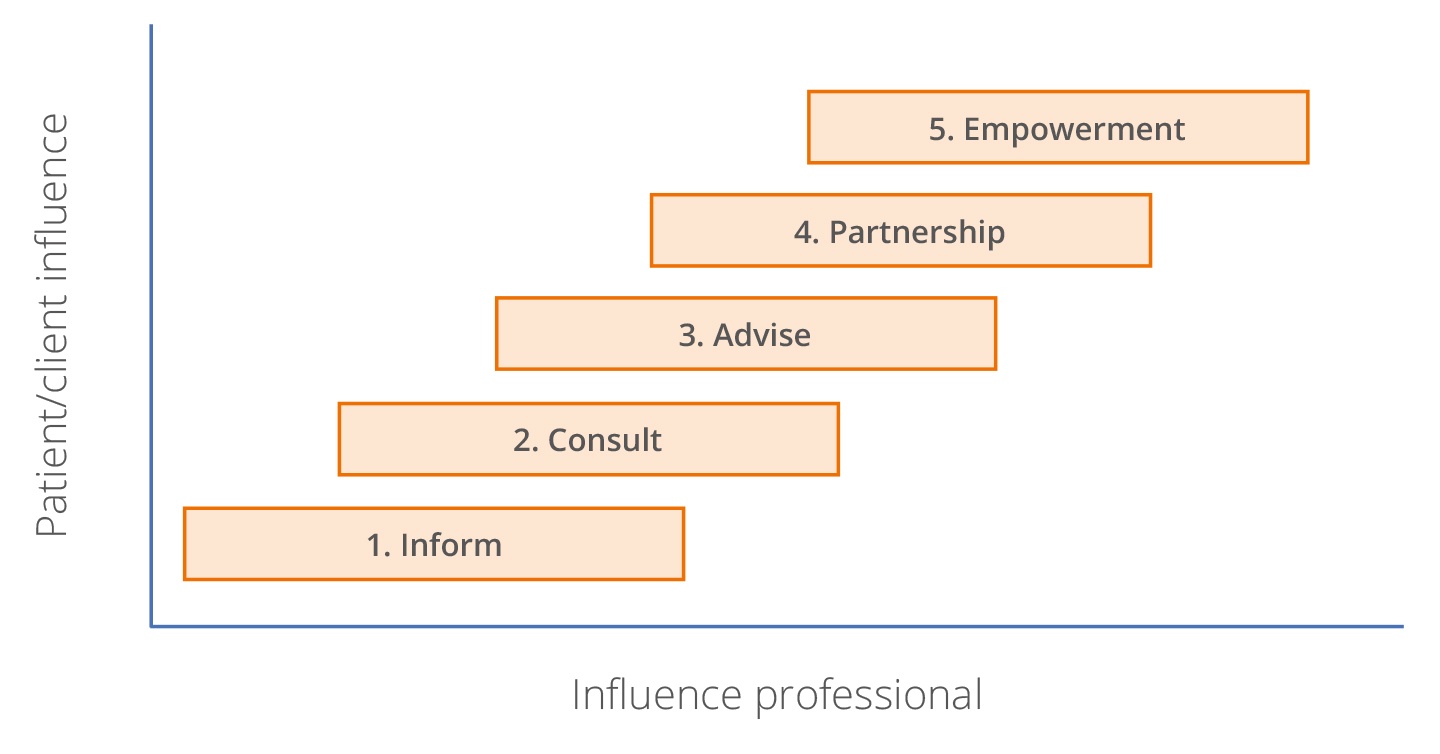How to choose the right tool for patient/client participation?

Table of contents
There is a growing recognition that actively listening to experiences of patients/clients and their relatives can substantially improve the quality and safety of care, without major change processes being necessary. We call this patient/client participation. In a previous blog we describe how to identify the right participants. This blog describes what decisions you need to make in order to select the right tool for patient/client participation.

Forms of patient/client participation
The form of participation depends on the way patients/clients are involved. They can merely be given information, but they can also be asked to participate in the decision-making process for certain issues. The type of activity in which you want patients to participate and the objective of the participation together determine the most appropriate form of participation.
The ladder of participation is a useful tool. It distinguishes five forms of participation that indicate the level of participation for each of them. The higher up the ladder, the more influence patients are given. On the last three steps, advise, joint decision-making, and patient holding the reins, patients play an active role and (also) take initiative.

An equal cooperation arises as soon as the patient takes part in the decision-making process. Patients/clients have their own role within the joint decision-making process with the professional. This is not necessarily a treating doctor or caregiver. The term professional may also relate to the management and executive board of a healthcare organization. Together they decide what they want to discuss, whereby the professional in principle commits himself to the outcome of the conversations.
3 basic requirements for patient participation
Patient/client participation is never an end in itself, but a means to achieve better healthcare. Actively listening to the experiences of patients/clients and their relatives can substantially improve the quality and safety of care, without major change processes being necessary. When patients/clients are involved, it is important to take three basic requirements into account:
- Be open to the positive effects of patient/client participation.
- Accept that each patient/client is unique.
- Choose the appropriate tools.
Objective of patient/client participation
Before the care institution can start patient/client participation, it is important to first specify the objective of the participation.
Different objectives of participation may include:
- Making services meet individual needs: guide individual patients (and/or their relatives) through the care process and help them find the appropriate care that fits with their individual preferences and needs.
- Understanding of preferences/needs: patients communicate what they need and changes they would like to see in the care process.
- Understanding experiences: patients indicate how they (have) experience(d) the care received and the subsequent effects on their daily life.
- Generating new ideas: patients, either independently or together with professionals, think of new ideas to improve bottlenecks in the care.
- Testing new ideas: present ideas for improvements in the care process to patients having first-hand experience or patient representatives for a possible reaction from them.
Usually we are looking at a combination of objectives. It is, however, important to determine the primary objective.
At what time during the improvement process do you involve the patient/client?
The form of participation also depends on the current stage of the project or process. The desired role of the patient/client and the form of participation differ per stage. Overall we can distinguish the following stages in every decision-making process or care development process:
- Preparation
- Implementation
- Evaluation
- Revision
When patients/clients are involved at an early stage they can be asked for their preferences and needs and they can be integrated with those of the institution. When patients are given a role in the revision stage, the impact on the overall process will be less and the patient/client will have to meet different requirements. At this point a patient/client and their relatives can give a clear opinion on specific aspects of the process or share their experiences with certain aspects.
Level within the organisation
The choice for a particular form of participation also depends on the level within the organisation where participation is required. Individual contact between caregiver and patient requires a different form than involvement in decisions made by the management of a healthcare institution.
We can distinguish the following levels:
- Individual level - Individual contact between healthcare professional and patient.
- Process level - At this level within the organisation attention is focussed on one process. It may concern one care process, one organisational entity like a department or outpatient clinic, or a specific project.
- Organisational level - This concerns the organisation as a whole with connections between departments and processes within the organisation, such as, for example, the junction between primary and supporting processes. At this level strategic policy is determined.
- System level - The system, i.e. national and European laws and regulations, determine the framework within which an organisation operates.
One way to get input from patients, clients or their relatives is by a satisfaction survey. Learn more about developing a satisfaction survey in our software.
eBook about patient participation
Do you want to know more about patient participation and the tools you can use? Download the eBook 'How do you turn regular care into excellent care?'. Learn from practical examples how you can use patient participation to improve the quality and safety of healthcare.
Related articles
-
 Communication Patient participation
Communication Patient participationWhy it is important to follow up on patient complaints
Receiving patient complaints can often be intimidating. But feedback can be valuable. This blog explains why a good follow-up is important.
Read more -
 Patient participation
Patient participationHow to make patient/client participation a success?
How do you make sure that your organization learns from patient participation initiatives? This blog describes important factors for success
Read more -
 Communication Patient participation Healthcare
Communication Patient participation HealthcareParticipation: How to give patients/clients a voice?
This blog describes various tools that you apply to give patients and clients a voice with the aim of improving the quality of care.
Read more